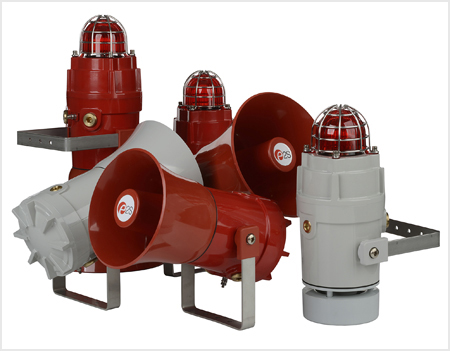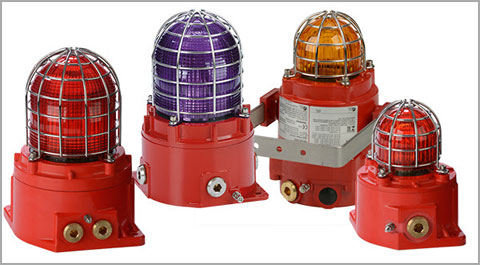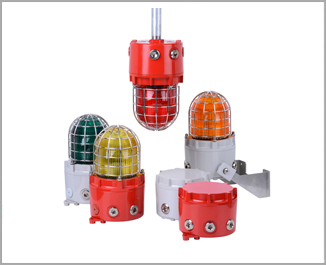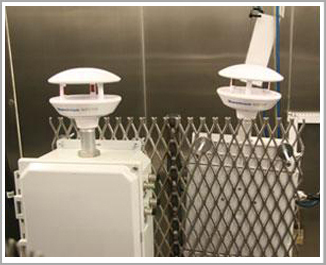
PE2S Warning Signals provide the critical final link for the Philippines’ tsunami warning system Released 27 April 2015
The 26 December 2004 Indian Ocean Tsunami killed 230,000 people in 14 countries, and swamped coastal communities with waves up to 30 metres high. Following this tragic event, the UN set up the Indian Ocean Tsunami Warning System, and although not directly affected by the 2004 disaster, the Philippines have set up a similar early warning system. Areas on the west coast of the islands, which face the Manila trench located between The Philippines and Vietnam, are at particular risk and the project is being progressively rolled out from the densely populated coastal towns and cities to the rest of the region.
PPSMPL serves the growing demands of industries like Chemicals, Oil, Gas & Petrochemicals, Pharmaceuticals, Steel, and Refineries as well as major Capital industries. PPSMPL aims to provide unique service levels to our customers by continuously improving our ability to assess and surpass their needs.
The system includes detectors, a GSM data communication system, data visualisation, interpretation, local tsunami emergency decision tools and, the final public-facing element of the system, widely distributed local tsunami warning stations.
The solar powered local tsunami warning station rely on E2S Warning Signals’ A121AX Appello 126 dB(A) output user-recordable alarm horns, which have a 300 metre effective range, to generate the audible alarms to alert the population to an impending emergency. Three units per station, spaced at 120° intervals, ensure all-round audibility, and the units generate warning alert tones followed by recorded messages to ensure that the warning is unambiguous. In the event of an emergency, people living in the affected coastal areas are given sufficient time to flee their homes and follow designated evacuation paths leading to higher grounds.
The A121AX can store, in non-volatile permanent memory, up to 2 minutes (4 x 30 seconds) of user messages, with independent volume controls for the 45 embedded alarm tones and the recorded messages. It operates from 24 VDC and is environmentally sealed to NEMA 4/4X/3R/13 and IP66 standards.
• To view all E2S press information, go to www.parkfield.co.uk/e2s
E2S Warning Signals takes part in its first NFPA show in Chicago 22 – 25 June 2015
Released 05 May 2015
On Booth 1162 at the NFPA Conference & Expo in Chicago, 22 – 25 June, E2S Warning Signals, the world’s largest independent manufacturer of audible and visual warning devices, will be showcasing its comprehensive product portfolio. On display will be a selection of devices suitable for use in Class I & II Division 1 and 2 areas amongst which there will be the new D1x series, available as combined horn and strobe units, horn sounders or PA loudspeakers.

The D1x family at NFPA 2015 Headquartered in London, UK, E2S has been manufacturing warning signalling devices for over 20 years combining the latest technology with leading industrial design and build quality. E2S collaborates with system integrators and application engineers to develop custom signalling solutions with substantial benefits such as ease of interface, quick installation and specific performance criteria. Through its Houston based distribution hub and a worldwide network of representatives E2S supplies over 350 product variants covering hazardous locations, marine and industrial applications; all available on fast lead times and backed by a 5 year guarantee.Personnel from both the E2S Houston and London facility will be on stand-by at the booth to discuss your signalling requirements.

E2S: A comprehensive range of auto-synchronising beacons with a choice of four housing materials
A comprehensive range of auto-synchronising beacons with a choice of four housing materials. The E2S families of Xenon and LED beacons offer a comprehensive choice of output levels for use as warning beacons and status indicators for systems installed in hazardous areas and industrial environments. Xenon beacons are available in 5, 10, 15 and ultra-bright 21 Joule versions, giving peak light outputs up to 900 Effective candela. LED beacons offer five flash rates for warning beacon use: 1, 1.5 and 2Hz single flashes and double and triple flashes; the output in flash mode is 338 cd with a current draw of only 110mA at 24VDC. They also have high and low power steady modes for status indicator uses - enhancing the typical life of more than 60,000 hours. All E2S beacons are compliant to SIL 1; the addition of fault diagnostics in selected models supports the higher SIL2 requirements by enabling the control system to interrogate the devices' operational status.
The same light engines and control electronics are at the heart of beacons available in all the product families in the E2S range. All versions use the same light engines and control circuitry with a choice of housing materials: STEx (316L stainless steel), the GNEx (GRP) and BEx and D2x (marine grade LM6 aluminium enclosures), providing a variety of mechanical protection, corrosion resistance, weight and prices to suit different environmental requirements and applications. The Polycarbonate, UV stable lenses are available in Amber, Blue, Clear, Green, Magenta, Red and Yellow. Whilst enhancing the light output, the lens filters are also field replaceable, enabling the reassignment of beacon function to be a simple and quick process.
Key benefits :
- All models are SIL 1 compliant, selected models support SIL 2.
- Xenon and LED light sources.
- Low current draw LED units potentially reduce the size and cost of battery backup and cables.
- 316L stainless steel housings.
- Lightweight GRP housings.
- UMarine grade copper free LM6 alloy housings.
- ATEX and IECEx approvals.
- A choice of lens colours to differentiate functionality.
- Auto-synchronising of all units on the same circuit.
E2S |
05 May 2015 |
E2S Warning Signals takes part in its first NFPA show in Chicago 22 – 25 June 91-22-28506015 |
|---|---|---|
On Booth 1162 at the NFPA Conference & Expo in Chicago, 22 – 25 June, E2S Warning Signals, the world’s largest independent manufacturer of audible and visual warning devices, will be showcasing its comprehensive product portfolio. On display will be a selection of devices suitable for use in Class I & II Division 1 and 2 areas amongst which there will be the new D1x series, available as combined horn and strobe units, horn sounders or PA loudspeakers.Headquartered in London, UK, E2S has been manufacturing warning signalling devices for over 20 years combining the latest technology with leading industrial design and build quality. E2S collaborates with system integrators and application engineers to develop custom signalling solutions with substantial benefits such as ease of interface, quick installation and specific performance criteria. Through its Houston based distribution hub and a worldwide network of representatives E2S supplies over 350 product variants covering hazardous locations, marine and industrial applications; all available on fast lead times and backed by a 5 year guarantee.Personnel from both the E2S Houston and London facility will be on stand-by at the booth to discuss your signalling requirements. |
||
SENSIT |
Feb-15 |
SENSIT® P100 Carbon Monoxide sensor credited with saving lives |
SENSCIENT |
12th May 2015 |
Senscient to Present Paper at Hazards 25 Senscient will be presenting a paper entitled, "Detection Technology and Dispersion Modeling Used to Eliminate False Alarms and Improve Safety Performance on Terra Nova FPSO." |
12th Feb 2015 |
Senscient is a Finalist for two SPE Offshore Achievement Awards The Society of Petroleum Engineers selects Senscient as a Finalist in two categories for the 2015 Offshore Achievement Awards. |
|
2nd Feb 2015 |
Senscient selected to present at SOGAT 2015 Senscient CEO, Rajat Barua, has been invited to present Senscient's technology for sour gas leak detection at SOGAT 2015. |
|
19th Jan 2015 |
Senscient to exhibit at AOG Perth Australia. Senscient will be exhibiting its game changing toxic and flammable gas detection products at the Australasian Oil & Gas Exhibition in Perth on 11th to 13th March 2015 |
|
GASTRON |
15-05-14 17:04 |
Fire & Safety EXPO 2015(Korea) |
MORPHIX |
9-Jul-14 |
Morphix Technologies’ Explosives detection Kit Scores High in NTOA review www.policemag.com Morphix Technologies, a manufacturer of detection devices for dangerous chemicals, has announced that its TraceX Explosives Detection Kit has received a 4.32 out of a possible 5 points from the National Tactical Officers Association Member Tested and Recommended Program.†|

D1xB2 explosion proof SIL2 signals launching at NFPA 2019
The latest addition to the E2S Warning Signals D1x family are the D1xB2 beacons, which offer global approvals with SIL1 and SIL2 compliance. Light sources are available as either Xenon or LED. Strobes are offered in 5, 10, 15 or 21 Joule Xenon variants with four flash rate options and are approved for private mode fire alarm use to UL1638. The high-power LED array features a steady mode for status applications, five flash patterns and three remotely selectable alarm stages/channels. UL/cUL and ULC approved for use in Class I/II Division 1, Zone 1 and Zone 21 explosion proof environments and IECEx and ATEX certified for Zone 1 and 21 applications – a truly global solution. The UV stable polycarbonate lens filters, protected by a stainless-steel guard, are available in Amber, Blue, Clear, Green, Magenta, Red and Yellow. The lens design enhances the light output and is field replaceable, enabling beacons to be repurposed on site. Low inrush and operating current allow more units to be installed per circuit, simplifying system design and reducing cost. All beacons on the same circuit are automatically synchronised.
For installations requiring signals compliant to UL1971 for public mode fire alarm installation, as emergency signalling devices for the hearing impaired, the D1xB2XH1 and D1xB2XH2 provide the brightest, auto-synchronizing, solution available.
All variants employ an innovative enclosure with multiple cable entries: 2 × 3/4"NPT and 2 x M20 side entries and 1 × 3/4"NPT pendant entry. A threaded flame path enables quick installation and simplifies maintenance inspection; whilst the large termination area maximises cabling space. The lightweight, marine grade aluminium corrosion resistant enclosure can be either conduit or surface mounted, utilising the built-in mounting lugs. An optional stainless-steel mounting bracket is available providing fully adjustable positioning in any direction for optimum effectiveness.
In addition to the stand-alone beacons, the D1x family includes combination units that provide sound outputs up to 116 dB(A) with 64 user-selectable alarm tones and four remotely selectable stages/channels to support audible signalling of multiple scenarios from a single device. The integrated Xenon beacon can be linked internally to the alarm horn to minimise cabling requirements and installation time and the alarm horn and strobe can be initiated simultaneously or independently.
E2S Warning Signals will be exhibiting the new D1xB2 products at the NFPA C&E in San Antonio (17th to 19th June 2019) – stand 1445.

SENSIT Technologies developers win EPA Wildland Fire Sensors Challenge
Sensor developers Jason Gu and Bryan Tomko of SenSevere and SENSIT Technologies along with R. Subramanian of Carnegie Mellon University, received the first place award for the EPA Wildland Fire Sensors Challenge. EPA and partners presented awards to the winners at the Air Sensors International Conference on Sept. 12, 2018, in Oakland, California.
About the Challenge :
In 2017, EPA and five other federal agencies issued a Wildland Fire Sensors Challenge to improve smoke monitoring and provide data to protect public health. EPA’s federal partners are the U.S. Forest Service, NASA, National Oceanic and Atmospheric Administration (NOAA), Centers for Disease Control and Prevention (CDC), and National Park Service (NPS). The winners of the Challenge used emerging technologies including miniaturized direct-reading sensors, compact microprocessors, and wireless data communications to develop prototypes for measuring smoke from wildland fires. The air sensor prototypes submitted underwent rigorous two-phase laboratory testing by EPA and the US Forest Service (USFS), a federal partner, for accuracy over a wide range of operation requirements relevant for wildland fire deployment.



